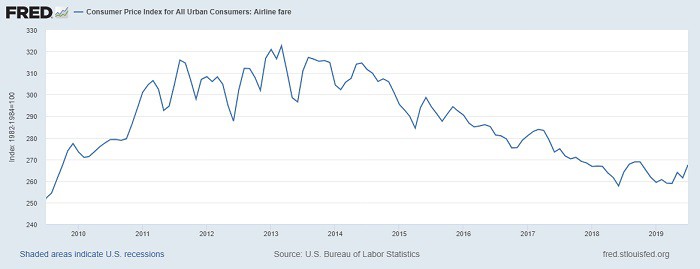Will T-Mobile/Sprint Merger Increase Prices?

Lots of things influence prices and, of course, not all are influenced by the same factors. However, the lawsuit filed by several state attorneys general against T-Mobile/Sprint merger explicitly links the number of competitors in wireless market places to lower prices in several places. Here are a few examples:
- “Preserving vigorous competition for mobile wireless telecommunications services is essential to ensure continued innovation and low prices for American consumers.”
- “This increased market concentration will result in diminished competition, higher prices, and reduced quality and innovation.”
- “Direct competition between Sprint and T-Mobile has led to lower prices, higher quality service, and more features for consumers.”
Since the suit so directly links the quantity of competitors in a marketplace to prices, it is fair to look at what has happened to prices in other industries with recent significant mergers. The airline industry provides a particularly strong parallel.
While these industries have obvious differences, there are several striking similarities. First and foremost, both are network industries. This means that both firms are advantaged by how extensive a geographic area and/or the number of people they can potentially serve.
These markets are also similarly concentrated. While there are many small and new entrants to the mobile phone and Internet sector, most of the marketplace is controlled by Verizon, AT&T, T-Mobile, and Sprint. Looking to the airlines, Southwest, Delta, American, and United form a clear top four as well. There is a significant drop off after both United and Sprint to the next closest competitor.
These markets are also subject to comparable market entrance and participation, which are heavily regulated at the federal, state, and local level. Local and state governments control gate access at most airports as well as access to rights of way and other infrastructure to install cellular towers. The air itself is regulated on the federal level in both markets: the Federal Aviation Administration through air traffic control and the Federal Communications Commission through spectrum allocation.
This is all to say that similar market and regulatory forces impact these industries to a sufficient extent to examine what happens to prices when major mergers occur. One such merger recently did in the airline industry.
American Airlines completed its merger with U.S. Airways in 2013. Prior to the merger, American and U.S. Airways represented the third and fifth largest domestic carriers by passengers, respectively. Did airline ticket prices increase with this new level of market concentration? No—since 2013, ticket prices have steadily and unmistakably declined:

Further, a recent analysis published in the International Journal of Industrial Organization found that recent airline mergers have been “pro-competitive.” The study concludes the following:
The effect of the recent legacy mergers in the airline industry have generated much debate, with many claiming they have led to anti-competitive effects including fare increases and output reductions… We find no such effects on overlap routes and thus no support for the claims of anti-competitive effects… [O]ur results demonstrate pro-competitive output expansions on nonstop overlap routes indicating reductions in quality-adjusted fares and a lack of significant anti-competitive effects on connecting overlaps. Hence, our results demonstrate consumer welfare gains on overlap routes, without even taking credit for the large benefits on non-overlap routes (due to new online service, improved service networks at airports, fleet reallocation, etc.).
Mergers and acquisitions, as explained in previous parts of this series (here and here), are signs of healthy competition. They allow firms to increase efficiency in providing goods and services and direct more resources towards providing new products. In short, while the quantity of competitors decreases, the quality of competition increases. The number of competitors a firm faces is irrelevant if none can offer a product that sufficiently rivals their own.
From the results in a similarly networked, concentrated, and regulated airline industry, it is hard to see how the state attorneys’ general lawsuit achieves the goal of protecting consumers in the wireless market. There is no reason to suspect the T-Mobile/Sprint merger will necessarily increase prices. Instead, we should fully expect prices to decrease while consumers enjoy greater wireless service benefits (such as new 5G technology) and coverage regardless of their provider.